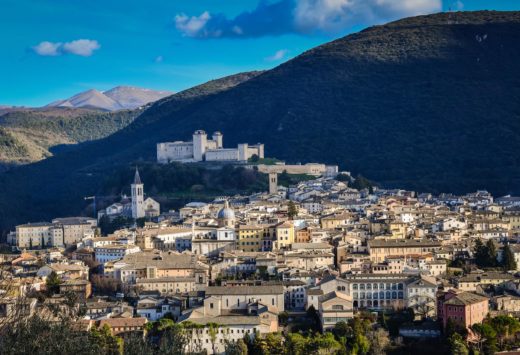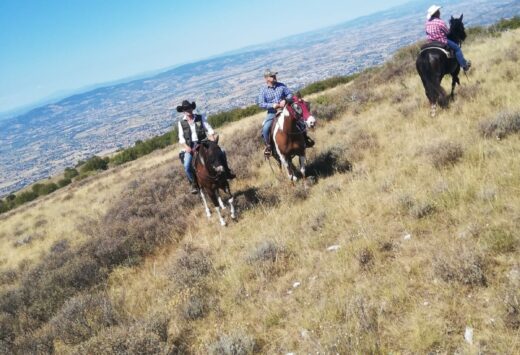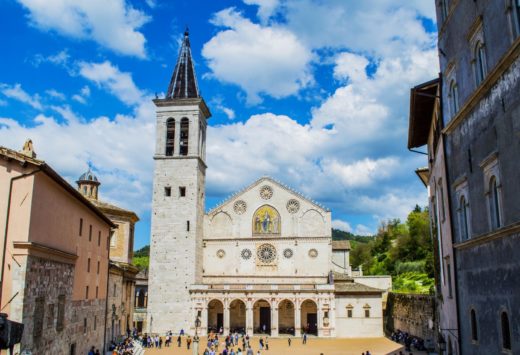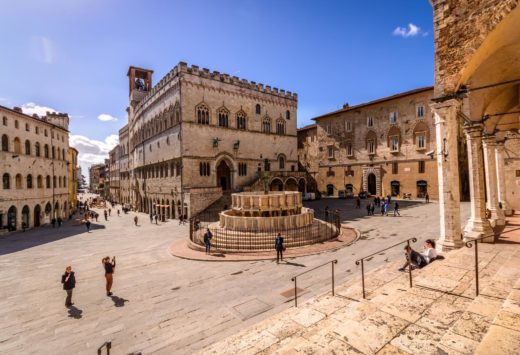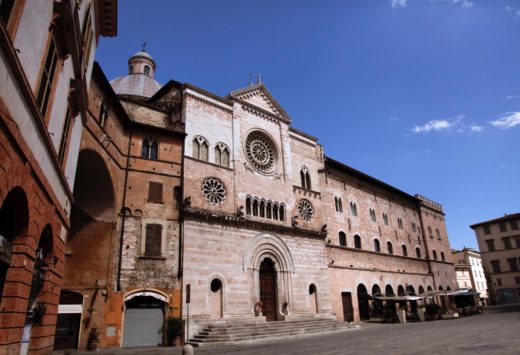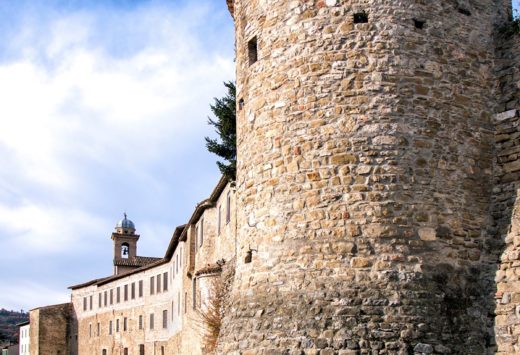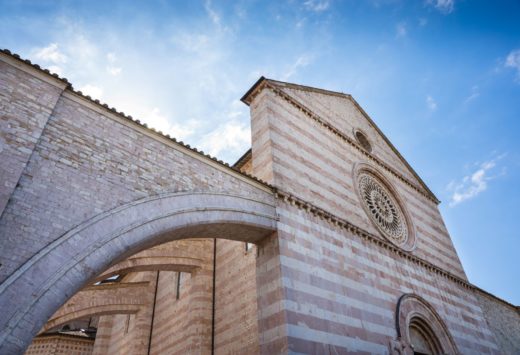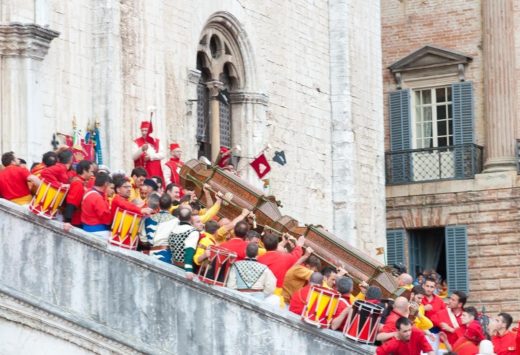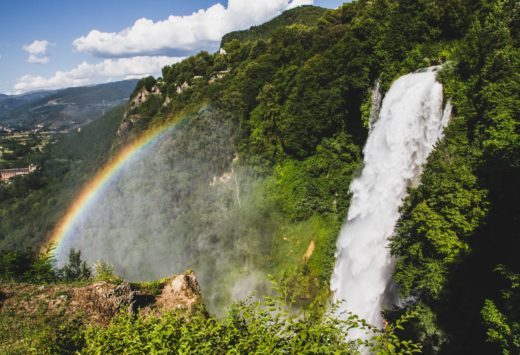ETRUSCAN-UMBRIAN PERIOD
The legend ascribes the origin of Assisi to Dardanus, a mythological hybrid whose descendants founded the city of Troy. According to the myth, he had built the city eight centuries before Rome was founded and, to give thanks to Athena, the Goddess of wisdom, handicraft, and warfare he erected a temple in her honour. The very same temple that to this day sits in the city square and – despite housing the church of S. Maria sopra Minerva – is the most important testimony of the classical period of Assisi.
The Asisinates were probably the first direct descendants of modern-day Assisians. They are included amongst the populations belonging to the Umbrian People by Pliny the Elder in his Naturalis Historia, written in the middle of the First Century A.D. The Roman historian and writer maintains that the Umbrians were one of the most ancient peoples in Italy. Assisi was therefore Umbrian and experienced a perpetual relation and conflict with the Etruscan Perugia up to the III Century B.C. when both cities passed under Roman rule. The influence of the Roman Res Publica put a temporary end to the clash between the two neighbouring and almost specular cities, but the rivalry never really ended and it would mark the entire history of the region. The Romans, in their infinite wisdom, never established a direct rule and let the Marones – indigenous Umbrian magistrates – administer the city with a certain degree of autonomy. Assisi became a civitas foederata, meaning allied community, since the beginning of the first century B.C.
Tracing back the steps of pre-Roman Assisi is a rather strenuous but very exciting task. The remains of the Umbrian and Etruscan civilisations, after more than two millennia, became rarer and rarer; but there is always a lead and it starts from the archaeological collection of the Roman Forum in the middle of the city square, which hosts an exhibition of inscriptions, and the Diocesan Museum of the S. Rufino Cathedral, where you will find beautiful architectural sculptures called Antefisse, still embedded in the foundations of the parsonage.
ROMAN PERIOD
Soon Christianity spread throughout Roman Assisi and its first martyrs appeared, above all Rufinus. Rufinus was the first bishop of the city and he came to Rome in the Fourth Century from a Turkish province to preach the gospel, facing the opposition of the authorities. When consul Aspasius learned about him, he sentenced the bishop to torture and had him thrown in the Chiasco river, near the village of Costano, with a millstone tied to his neck. Today Rufinus is the patron saint of Assisi and the cathedral that bears his name and hosts his tomb is one of the city’s oldest and most beautiful.
With all probability, already during the first Imperial Age, Assisi was renowned for its therapeutical air, due to the sacredness and healthiness of the land. Many aristocratic groups who lived in Rome had houses built here in order to control property, basically making Assisi their holiday resort. This led to the rise of Liberti, meaning freed slaves, who administered properties in the city on behalf of the owners. A famous example is the case of Publio Decimio Eros Merula who was a surgeon, optician, and benefactor for the city. He made donations to pave the streets and restore statues in the Temple of Hercules, as inscribed on the epigraph displayed in the archaeological collection of the Roman Forum.
As opposed to previous civilisations, the Romans left very recognisable traces in Assisi. In the underground of Piazza del Comune, Assisi’s city square, the Roman Forum can still be visited and is in excellent conditions. The Forum was not supposed to be the centre of the settlement, which developed farther upstream, but rather a sanctuary to celebrate the waters that, with all probability, poured directly into the temple. Going back from the square you will find other Roman ruins, such as the perimeter wall of a cistern, the remains of an aqueduct, a theatre ‒ now privately owned ‒ and an amphitheatre. Finding the amphitheatre on foot is not the easiest task; If you look at how buildings are arranged around Piazza Matteotti on a map you’ll easily pin-pot the site: today’s houses are built on the foundations of the amphitheatre and they are organised in the typical Roman elliptical section.
But the most prominent personality of Roman culture in Assisi is indubitably Propertius, one of the greatest poets of the Classical Period. Probably born in Assisi’s countryside, in the fraction of Collemancio, his Elegies would become, especially during the Neoclassical Period, a lyrical milestone that inspired the likes of Ariosto, Tasso and Goethe. If you want to know more about him, just pay a visit to the Domus Sesto Properzio, under the crypt of the Church of S. Maria Maggiore. There you can admire ancient and beautiful frescoes and the inscription that helped researchers link those places to the house where the poet lived during his youth, before moving to Rome.
MIDDLE AGES
After the fall of the Roman empire, also Assisi would inevitably be sucked into the downward spiral of the Middle Ages. During the X, VI, and VII Century, the traces of the passage of Germanic populations – due to a limited use of writing and poor building techniques – become increasingly scarce.
All we know is that with the end of the Roman rule, which is conventionally set to 476 A.D., Assisi falls into a turbulent and dark period which, save for some short brakes, would wear out the city until the unification of Italy. Sieges and occupations would alternate incessantly since the beginning, starting with the initial conflict between Germanic and Byzantine populations. At first Theoderic the Great’s Gothic Stronghold, the city then passed under the influence of the Byzantine General Belisarius, in 545 Assisi is invaded by Totila‘s Ostrogoths, just to be back in Byzantine hands a few years later with Narses in 552. The end of the VI Century marks the beginning of a period of relative peace under Alboin, king of the Longobards and the annexation of the city to the Duchy of Spoleto. Two centuries later, the Longobard Kingdom will fall under the sword of Charlemagne and his impressive army. The rule of the Franks and the new Carolingian Empire seem not to have left any trace in the city, while being rather evident in the peripheral areas where the never-ending wars forced the governors to defend their cities with encastellation systems. Many of the castles at the feet of the hill, and the enchanting little villages that rose around them, were erected around this period. The castles of Torchiagina, Tordandrea, Castelnuovo, Sterpeto and Petrignano are some of the settlements that began to develop during this time and represented the first line of defence for the city.
This system lasted until 1174, when the troops of the German emperor Federico Barbarossa, after conquering the majority of Northern Italy, broke into Assisi. Coming from a family that knew a thing or two about castle construction techniques (his nephew, Federico II, built Castel del Monte), he gave order to erect the castle of Rocca Maggiore for his brief stay.
THE MEDIEVAL COMMUNE
But even the Rocca castle was impotent against the powers that were raising in Italy at the time. One one hand Pope Innocent III and his expansionist campaign in Central Italy, on the other the other the communal institutions that were spreading throughout the region. In 1198 a popular uprising dismissed the imperial power establishing a communal government in Assisi, with its consuls and the Capitano del popolo (captain of the people); it goes without saying that ecclesiastical institutions where behind all that. This is pretty much when the endless rivalry between the Guelphs – endorsed by the Pope – and the Ghibellines – advocating imperial power – begins. The same dynamic applied to the juxtaposition between Perugia and Assisi: at times one was Guelph and the other Gibelline, some other times it was the opposite.
In the meantime, between 1181 and 1182 in a small house in the city centre, where now sits the church of Chiesa Nuova, Giovanni di Pietro di Bernardone was born. He would become the most important man of Assisi and one of the most famous personalities of the western world. If that name does not sound familiar to you, maybe this would ring a bell: Francis. Saint Francis of Assisi.
It would be arduous to cover in these pages the life and deeds of the man who single-handedly revolutionised – and in all likelihood saved from a never-ending crisis – the Catholic Church through the return to values such as peace, pauperism and fraternity. There is no better way to know the story of Francis than exploring his home town. In each church you visit, each street you walk, each artwork you enjoy, you will discover a new chapter of his fascinating story. In the myths and deeds that have been preserved in his hagiography you will discovery the sanctity and importance of the values of which he was the bearer, in his life events and historical records you will find the beauty and simplicity of the Everyman.
During the period immediately following Francis’ death in 1226 and his canonisation two years later, the Seraphic City reaches its artistic and cultural peak. All of a sudden the streets are flocking with pilgrims from all walks of life, from the poor and the leaper, to the prince and the cardinal. Painters, sculptors, makers, and artists of all sorts come from all over the world creating a melting-pot of different cultures and artistic styles.
The places we now admire in awe would have never been that wonderful if a man, shortly after Francis’ death, had not fought to build them so magnificently. Elia of Cortona, friar of the monastic order founded by the Saint, went to great lengths to build the two Churches dedicated to Francis: Basilica Inferiore and Basilica Superiore. The principles of humility and frugality preached by Francis and followed by his order sparked a very long and heated debate on how the institutes bearing his name should be built. If it hadn’t been for Elia, instead of the Basilicas of Saint Francis, Basilica of Saint Clare, Basilica di S. Maria degli Angeli, and many other wonderful and majestic Franciscan Monuments, we would have small and anonymous buildings, free from any form of embellishment or precious objects, as the Rule provided. Thankfully things went differently. One could play a game while walking around the city and imagine how it would have looked if the Franciscan Rule had been observed, wondering whether and how this would have affected the history of the city, Italy, and the Church itself.
Only the Franciscan experience managed to give back a few decades of peace and serenity to the city. But soon enough hostility, resentment, and violence between the two factions were resumed at full capacity in a rising spiral of brutality. In 1319, due to the continuous raids of Muzio Brancaleoni‘s Ghibellines, the whole city was excommunicated by Pope John XXII in person depriving its citizens of sacraments and Christian burials for over 30 years. Later the city fell back under the pontifical aegis again with Cardinal Albornoz who, in order to avoid the uprising of the heretic rebels, reinforced the city walls and fortifications, adding the castle of Rocca Minore, connecting it with Rocca Maggiore via a long corridor.
Towards the end of the XIV Century, internal struggles are back harsher than ever: The rivalry between the two fractions, the Guelphs lead by the Nepis family and the Ghibellines under the command of Guglielmo di Carlo (Muzio Brancaleoni’s nephew), liteerally split the city in two; the Parte di Sopra, the upper part that includes the quarters of Porta Perlici, S. Chiara and S. Maria Maggiore and the Parte di Sotto, the bottom part incorporating S. Francesco, S. Giacomo and S. Pietro. The separation is so pronounced that the city will remain split forever. To this day, once a year, history is revived in the Calendimaggio celebrations; but worry not, you will not risk your life or excommunication.
RENAISSANCE
Not even the prosperous age of Renaissance, which blessed the whole peninsula with culture and beauty, could bring peace to the Umbrian city. Throughout the whole XV Century Assisi is torn apart by the frequent raids of Perugian warlords who take over the city on many occasions and are cyclically thrown out by the allies of the Papal States, such as the Sforza and Montefeltro. In 1398 Braccio Fortebraccio da Montone invaded the city with the intention of going back to Perugia from where he had been recently exiled. In 1442 Niccolò Piccinino, with the help of a treasonous friar, managed to get past the city walls and destroy everything on his path. Legend has it that, dazzled by Assisi’s beauty he refused the 15,000 Florins that the Commune of Perugia offered him to raze it to the ground.
Assisi was on its knees, destroyed and deserted. Around the end of the century the internal clashes are resumed one more time. The Guelph Parte di Sopra, supporting the Baglioni family and the Ghibelline Parte di Sotto, fighting along with the Oddi family. And again, at the beginning of the new century, it will be the turn of the Valentine, Cesare Borgia, to wreck havoc with it; on the pretext of returning the city to the Pope he ransacks and destroys any church he can get his hands on.
If this was not enough, besides the tragically famous epidemic of 1348, between 1416 and 1526 twenty-six outbursts of plague had been recorded. An average of one every four years, during which time citizens were forced to abandon the city tempting fate through the hardships of the countryside or mountainous regions, or stay and face certain death. With the first half of the XVI Century, Assisi officially becomes part of the Pope States entering a new peaceful but, paradoxically, even poorer era.
MODERN AGE
The period of relative peace and stability in the Franciscan city would last for about two centuries, until the rise of a new threat for Italy: Napoléon Bonaparte. Between the end of the XVIII and the beginning of the XIX Century, Assisi was occupied by the French troops who ravaged the city churches stripping them from their treasures and several works of art. According to the records, more than 500 Kilos (1,000 pounds) of wrought silver were stolen from the Basilica of Saint Francis alone. During the first years of the XIX Century the city was incredibly poor, there were no signs of industrial or commercial activity of any kind and most people had fled. The majority of citizens moved to the countryside, hoping to survive by joining the only economy available: agriculture. Making things worse, in 1832 a brutal earthquake tore down the city, heavily damaging most of its monuments; only the Basilica of Saint Francis could escape such fate. The dome of Basilica di S. Maria degli Angeli collapsed, but the Porziuncola – priceless site of Franciscan history – was miraculously spared. What made the phoenix rise from the ashes and reawaken the cultural and economical spirit of the city was, once again, a sacred event for the Franciscan Cult: the finding of the bodies of Francis and Clare. In 1818, by order of Pope Pius VII, after 52 nights of hard work the body of Francis was exhumed from underneath the altar of Basilica Inferiore. The news spread all around the world attracting millions of pilgrims, devotees or ordinary visitors curios to see the remains of the famous saint, which were being displayed in the Basilica’s crypt. The remains of Saint Clare, Francis’ disciple and protegée and founder of the Franciscan female order of the Poor Clares, were found a few years later in 1850.




